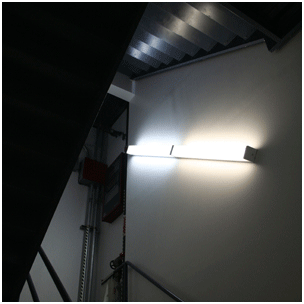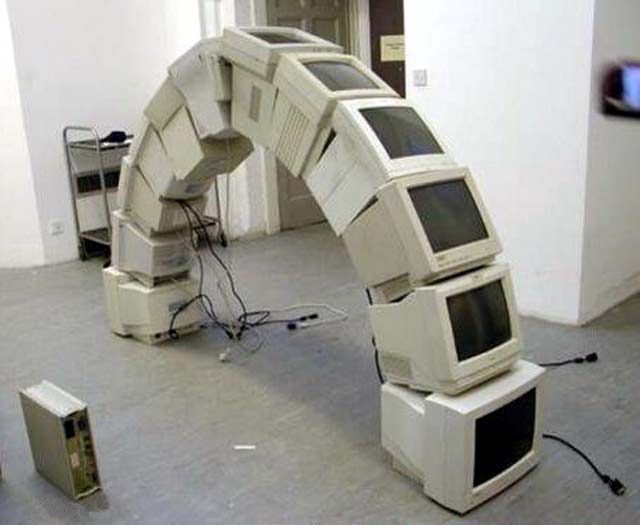Quick As a Wink
Change to SpareTransport of the mails, transport of the human voice, transport of flickering pictures - - Antoine de Saint-Exupery All of the books in the world contain no more information than is broadcast as video - Carl Sagan A Flicker of Interest
Source: thetreehouseandthecave.blogspot.com Andrew Coulter Enright by David Jones The human eye is sensitive to change above all else. Hence the flashing indicator for cars, the blink comparator and the flicker photometer, and the blinking cursor on the computer screen. Indeed, says Daedalus, hence the strange and terrible authority of the computer screen itself, and of the TV and cinema screen as well. The subliminal flicker of these hypnotic displays rivets the attention and subverts the mind. So Daedalus wants to give printed text and pictures, and indeed objects in the real world, the eye-appeal of constant flicker. What is needed is a dye whose reflectivity is not steady, but oscillates about a mean value. Ordinary phosphors absorb light and emit it later. The photon energy is stored in the crystal structure as excited unpaired electrons. So Daedalus is inventing an oscillating phosphor. He recalls that unpaired electrons are paramagnetic. An excited state should therefore induce a local magnetic field; and the rate at which it decays should depend on the local field. DREADCO solid-state physicists are therefore growing tiny phosphor crystals each containing a two-state magnetic inclusion. The idea is that the phosphor will absorb light until its growing field "flips" the magnetic element. This will trigger the rapid re-emission of light; the field will decay and the magnetic inclusion will flip back. The result will be an unsteady, oscillating phosphor, driven by the energy of the light falling on it. It will brighten and darken endlessly about its mean reflectivity. Artists and ad-men will rush to exploit the new products. DREADCO's "Wink" inks and paints will flicker beckoningly from posters, magazines and the more garish of fashion clothes and accessories. Warning signs, safety regulations, identifying marks and disclaimers in contracts will signal their importance in unmissable Wink. High-frequency Winks, compelling subliminal attention without it being obvious why, will revolutionise the cosmetics industry. Its customers, without seeming garish or blatant, will now be able to call subtle attention to their most charming features. Long-period Winks will alleviate the visual boredom of institutions and offices; they will even vary in frequency with the ambient illumination. In theatres and clubs, strobe lighting on Winked decor will induce amazing interference effects. Sadly, patrons may be at risk of epileptic fits. Source: Nature Vol 405 4 May 2000 from David Jones' "Daedalus" column
Moving Picturesby David Jones Last week Daedalus devised a phosphorescent paint which absorbed and re-emitted light intermittently. When enough trapped unpaired electrons had accumulated in a crystal of its pigment, they switched a bi-stable magnetic inclusion which encouraged their radiative decay, and flipped back again when they had done so. The result was DREADCO's "Wink" range of oscillating-brightness inks and paints. Daedalus now realises that their brightness varies spatially too. Even the most uniform Wink surface must vary in switching frequency from point to point, if only from local variations of temperature and ambient illumination. So its flash phasing soon ceases to be uniform; some regions will be bright when adjacent ones are dark. The boundaries between such regions will tend to drift, for the magnetic field at an edge will influence the strip of Wink just outside it. Daedalus is exploring the sort of flicker-shapes that can form, and how they change under different patterns of illumination. The simplest instability is that of a long-period Wink surface on which regions of brightness form and wander, their shapes influenced by the changing illumination around them. As wallpaper or decor, such a surface would have the entrancing appeal of cloud-shadows moving over a landscape. As a kinetic camouflage or mutable dazzle-pattern, it might wonderfully obscure military vehicles - or indeed stolen cars - by distracting the observers' gaze. But the most lucrative use would be in poster advertising. A cunning enough initial pattern, controlled by a grid of many programmed heating coils under the surface, would develop entrancingly. It could tell a picture story, or dissolve into random swirls from which slogans or images would emerge at intervals, or even reverse itself by a sort of spin-echo recapitulation. And by changing the heating program, the poster could be switched to a whole new story. Wink patterns of higher frequency, in the flicker-fusion range, could induce new visual effects. A region winking at 50Hz (say), on a ground winking at 51Hz, should form a ghostly, subliminally compelling flicker-picture. Cunning flicker-field advertisements, all the more persuasive for their subtlety, should propel the consumer boom to new heights. Source: Nature Vol 405 11 May 2000 from David Jones' "Daedalus" column
The Further Inventions of Daedalus is published by Oxford University Press.
10 Questions Computers Might Ask Human Beings - and Vice Versaby David Taylor 10 Questions Computers Might Ask Human Beings
10 Questions Human Beings Might Ask Computers
David Taylor is the author of best-selling business book The Naked Leader (www.nakedleader.com), president of IT directors association Certus and a regular contributor to silicon.com. Source: silicon.com 3 September 2003 with thanks to Tony Buzan and Jonathan Loretto
I hope Mr Taylor isn't conflating the abilities of a computer with the capabilities of a network...
Arc de Triomphe
A Surprising Example of the Effectiveness of Subliminals
For IT-related articles on snooping, usage, the future, e-diaries, piracy, flickers, cyborgs, browsing, trends, jokes, philosophic agents, artificial consciousness and more, press the "Up"
button below to take you to the Table of Contents for this Information and Technology section. |
 Animals
Animals Animation
Animation Art of Playing Cards
Art of Playing Cards Drugs
Drugs Education
Education Environment
Environment Flying
Flying History
History Humour
Humour Immigration
Immigration Info/Tech
Info/Tech Intellectual/Entertaining
Intellectual/Entertaining Lifestyles
Lifestyles Men
Men Money/Politics/Law
Money/Politics/Law New Jersey
New Jersey Odds and Oddities
Odds and Oddities Older & Under
Older & Under Photography
Photography Prisons
Prisons Relationships
Relationships Science
Science Social/Cultural
Social/Cultural Terrorism
Terrorism Wellington
Wellington Working
Working Zero Return Investment
Zero Return Investment
